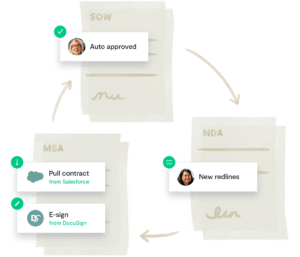Everyone’s been there, the mad, end-of-quarter sprint to close a flurry of key sales deals. It’s controlled madness on the Sales Floor—account execs frantically emailing and phoning potential clients, going over contract language, resolving redlines between parties, and pinging Legal for 11th-hour approvals.
With dozens of deals in the works and multiple sales people handling three to four contracts each, how does Sales logistically (and efficiently) close what needs to be closed and win the quarter without playing fast and loose with language and approvals?
At Ironclad, not surprisingly, our Sales team uses Ironclad, the digital contracting platform designed to fast track contracts for in-house legal teams and their business users. In Part One of a three-part series, we turn the spotlight on Ironclad Sales Engineer Alvin Cheng, who has a front-row seat to how Ironclad streamlines our own contract management process. In subsequent posts, we’ll hear from Sales leadership and Legal POVs.
Alvin, before we dive into how Ironclad does Ironclad, describe the sales contracts process you’ve seen elsewhere where everything is done manually.
Typically, a sales rep needs to go into a template folder, for example, on a company shared drive, to look for the right contract template. Unfortunately, there may be multiple versions, some with outdated language. If the rep picks the wrong one, it could have serious consequences down the line, delaying the deal.
I’ve actually heard all of these questions on the sales floor:
“Hey, has the client signed an NDA? If so, where is it?”
“Where is our latest standard sales agreement?”
“Has Legal approved the contract template?”
“Who else needs to approve the special terms?”
Finally, even if a rep finds the right agreement and language, there’s often a lot of duplicate, manual entry and formatting required, in both the contact itself and the company’s CRM, for example, Salesforce, before the contract make its way to the Deal Desk.
Logistically, this sounds cumbersome, so much back-and-forth. What are the benefits of using a digital contracting platform like Ironclad?
Right, contracting manually is cumbersome and error-prone. You might not have the right information when negotiating with a prospect and the pricing or terms of the contract might change mid-stream. And if it does, sales reps have to go through Legal all over again.
Our sales reps are always juggling priorities, watching over multiple deals with different terms, pricing and stakeholders—and keeping Legal and Sales leadership informed throughout the process. Obviously, our sales reps want to close contracts, so they have to make sure all redlines have been incorporated and that contracts have passed through all necessary review phases.
Ironclad’s approval routing really helps sales reps project manage their own deals, even letting them leave comments for deal stakeholders in other departments. In the end, this automation streamlines sign-off, even when contract terms are negotiated at the last minute.
How does Ironclad give different teams visibility into the contracting process?
From a management perspective, Ironclad makes it possible to track all deals in flight, and all negotiations or approval processes associated with those deals—from a central location.
From Legal’s perspective, being able to track all contract changes centrally and at a glance is so important.
And of course the head of Sales is quarterbacking everything and needs to see the Big Picture on the way to quarter end, maybe even minute by minute.
If you have 30 deals to close in a quarter, some of those deals might have small tweaks or changes negotiated by clients, for example support terms or SLAs. Ideally, you’re tracking all your obligations from a common platform. That way, you have a digital record of everything, not just in someone’s head or sitting in a private spreadsheet.
This no doubt maximizes every stakeholder’s time and effort, removing any blockers to deals closing.
Yes, they know what they have to look at and prioritize at any given moment, and they’re not spending time searching for documents in their inbox.
Towards the end of the sales process, for example, sales reps want to make sure they have a signed NDA in place and a contract ready to launch and create. Typically, the NDA is step one because we release sensitive information related to our product—it makes no sense to have the process stall on something so basic. Fortunately, Ironclad can let a rep know immediately if an NDA has been signed.
When it comes to the contracting workflow, sales reps kick off an order within Ironclad and fill in information on the type of company, pricing model, feature set we’re selling, and services including support and integrations. The contract that goes out for signature is customized based on their responses to a questionnaire and becomes part of an automated, end-to-end workflow enabled by our Workflow Designer, part of the Ironclad platform.
Streamlining contracting workflows
What about the value of integrating your contracting platform with your CRM, another “ideal state” moment?
Even better.
By integrating with Salesforce, Ironclad lets a sales rep kick start the contract process right from the tool they’re using every day, including quantity and price. They can even launch an NDA, go into Ironclad and click Submit. Then see contract status updates within Salesforce, for example, which department still needs to approve the contract.
In closing this out, let’s move on to formal review.
After the contract is generated, typically you want to review it internally. For example, our system automatically notifies the Sales VP and Legal team to make sure they understand the pricing, terms, etc. On Ironclad’s Activity Feed, everyone can see what action is happening related to the contract.
At quarter end, you may have dozens of deals closing in the course of a couple of days. Without Ironclad, it isn’t possible to process those deals quickly and systematically. Ironclad helps our teams prioritize their attention on the deals that are closest to closing. It ensures that changes, redlines, review and other necessary activities don’t fall through the cracks.
Then it’s on to the buyer’s side of the deal.
Once you loop in the buyer for a review, you see the same issues. You have the customer’s legal team reviewing your contract language and they might have changes to incorporate as well. Again, when everything from contract creation and language to redlines and sign-off is on the same platform, you can successfully process a high volume of contracts, accurately and on deadline.
In Part Two of Ironclad Is for Closers, we’ll take a look at how Sales leadership leverages Ironclad to win quarter end, making sure “time doesn’t kill deals.” For more on powering the Sales and Legal partnership, download our guide Dealmaker to Dealbreaker.
Ironclad is not a law firm, and this post does not constitute or contain legal advice. To evaluate the accuracy, sufficiency, or reliability of the ideas and guidance reflected here, or the applicability of these materials to your business, you should consult with a licensed attorney. Use of and access to any of the resources contained within Ironclad’s site do not create an attorney-client relationship between the user and Ironclad.




